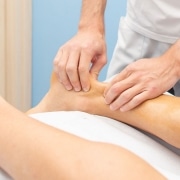Treatment Options for Ankle Pain
Many things could cause that pain in your ankle, including injury or chronic disease. Before your podiatrist in Pflugerville, TX, can treat your ankle pain, they must discover the source of your discomfort.
Achilles Tendonitis
Your Achilles tendon is the band of tight tissue that connects the heel of your foot to your calf muscles. And when you cause damage to this tendon, your body will let you know in several ways, including pain that feels as though it’s located in your ankles. Sports injuries are the most common causes of damage to the Achilles tendon, and as long as the damage is mild, such as from overuse, simple treatment plans will help alleviate pain. Treatment may include:
- Anti-inflammatory medications
- Simple stretching exercises
- Orthotic devices, such as wedges worn in shoes to deflect pressure from the tendon
- Surgery
Osteoarthritis
Osteoarthritis is a painful condition that can affect the ankle joint by wearing away the protective cartilage that separates the bones. Treatment for osteoarthritis may include:
- Pain relieving medications
- Anti-inflammatory medications
- Physical therapy
- Cortisone injections
- Surgery
Sprained Ankle
Sprains happen when you roll or twist your ankle so severely that it damages the surrounding ligaments. If you’ve ever had a sprain injury, you understand just how painful they can be. If your podiatrist diagnoses a sprained ankle, they may prescribe the following treatments:
- Wrapping the ankle with an elastic bandage
- Rest
- Application of ice
- Pain medication
If you’re suffering from the discomfort of ankle pain in Pflugerville or Austin, TX, call Dr. Jeffery LaMour, DPM, PA to set up an appointment today. One of our friendly and knowledgeable representatives will be happy to answer any questions you may have.
Sources
https://www.mayoclinic.org/diseases-conditions/achilles-tendinitis/diagnosis-treatment/drc-20369025
https://www.mayoclinic.org/diseases-conditions/osteoarthritis/diagnosis-treatment/drc-20351930
https://www.mayoclinic.org/diseases-conditions/sprained-ankle/diagnosis-treatment/drc-20353231







